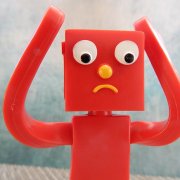Deep-learning models can spot patterns that humans can't. But software still can't explain, say, what caused one object to collide with another.
by Will Knight
Here’s a troubling fact. A self-driving car hurtling along the highway and weaving through traffic has less understanding of what might cause an accident than a child who’s just learning to walk.
A new experiment shows how difficult it is for even the best artificial intelligence systems to grasp rudimentary physics and cause and effect. It also offers a path for building AI systems that can learn why things happen.
The experiment was designed “to push beyond just pattern recognition,” says Josh Tenenbaum, a professor at MIT’s Center for Brains Minds & Machines, who who worked on the project with Chuang Gan, a researcher at MIT, and Kexin Yi, a PhD student at Harvard. “Big tech companies would love to have systems that can do this kind of thing.”
The most popular cutting-edge AI technique, deep learning, has delivered some stunning advances in recent years, fueling excitement about the potential of AI. It involves feeding a large approximation of a neural network copious amounts of training data. Deep-learning algorithms can often spot patterns in data beautifully, enabling impressive feats of image and voice recognition. But they lack other capabilities that are trivial for humans.
To demonstrate the shortcoming, Tenenbaum and his collaborators built a kind of intelligence test for AI systems. It involves showing an AI program a simple virtual world filled with a few moving objects, together with questions and answers about the scene and what’s going on. The questions and answers are labeled, similar to how an AI system learns to recognize a cat by being shown hundreds of images labeled “cat.”
Systems that use advanced machine learning exhibited a big blind spot. Asked a descriptive question such as “What color is this object?” a cutting-edge AI algorithm will get it right more than 90 percent of the time. But when posed more complex questions about the scene, such as “What caused the ball to collide with the cube?” or “What would have happened if the objects had not collided?” the same system answers correctly only about 10 percent of the time...
Read the full article on Wired.com using the link below.

